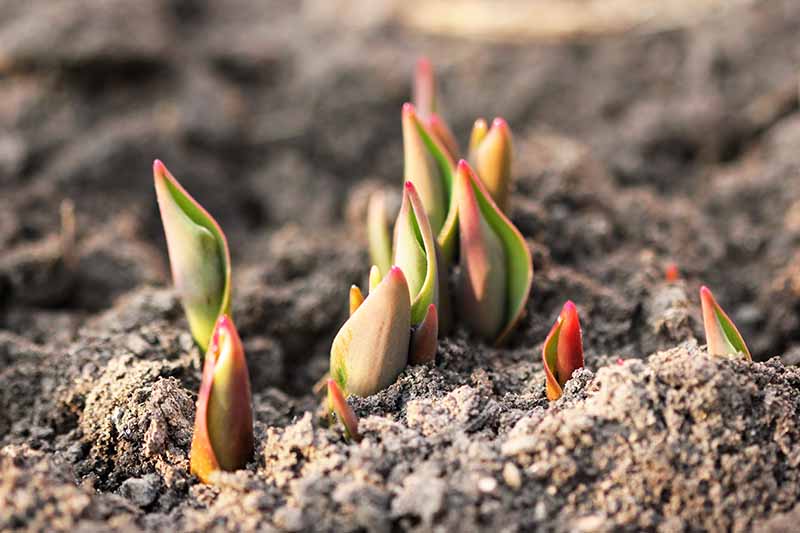Tulips are one of the most beloved spring blooming bulbs, bursting forth with colorful cups in shades of red, pink, yellow, white and purple. But before those showy blossoms appear, curious sprouts poke up from the ground. Learning to identify tulip sprouts ensures you don’t accidentally pull them while weeding.
When Do Tulips Sprout?
-
Tulips are among the earliest bulbs to sprout in spring, typically emerging in March or April.
-
Exact timing varies by climate and variety Darwin Hybrids and Fosteriana tulips sprout early while Single Late and Parrot tulips sprout later
-
Bulbs sprout 4-6 weeks after the average soil temperature reaches 40°F in spring.
What Do Tulip Shoots Look Like?
Tulip sprouts have a distinctive curled, noodle-like appearance. Here’s how to recognize them:
-
Reddish or green shoots – Many tulip varieties sprout with a reddish or purplish blush on the tips that fades to green as they grow.
-
Twisted, wavy leaves – The long, pointed leaves twist together into a spiral, resembling a pig’s tail or corkscrew pasta.
-
Smooth, slender leaves – Tulip foliage is smooth and grass-like with a rounded cross-section, not flat.
-
Single sprout per bulb – Each bulb produces one sprout. If you see a cluster, it’s likely something else.
-
Rapid growth – Tulip sprouts grow quickly, sometimes up to 1-2 inches per day once established.
What Do Other Spring Bulb Sprouts Look Like?
It’s easy to confuse tulip sprouts with other bulbs. Here’s how to tell them apart:
-
Daffodils – Wider, flattened leaves in fans vs. thinner twisted tulip leaves.
-
Hyacinths – Thick, stubby spikes that soon form flower buds vs. slender tulip shoots.
-
Allium – Narrow, grassy leaves in starburst pattern, spreading out in all directions.
-
Crocus – Delicate, iris-like leaves in bunches low to the ground.
-
Iris – Rigid, sword-like leaves emerging in fan shapes from rhizomes.
Caring for Tulip Sprouts
Once sprouted, tulip shoots need proper care and feeding:
-
Keep soil moist but not saturated while shoots are actively growing.
-
Remove any weeds that could compete for nutrients. Weed carefully to avoid damaging sprouts.
-
Apply a balanced bulb fertilizer or compost when shoots are 4-6 inches tall to fuel growth.
-
Stake taller varieties if needed to prevent damage from wind and heavy rain.
-
Remove spent flowers after blooming but leave foliage intact for 6-8 weeks so leaves can nourish the bulb.
When to Dig Up and Store Tulip Bulbs
It’s best to let foliage die back completely before digging up tulip bulbs:
-
Mark locations of bulbs to find them easily when dormant.
-
Lift bulbs when foliage turns yellow or brown in early summer.
-
Brush off excess dirt but don’t wash bulbs.
-
Allow bulbs to cure in a cool, dry spot for 4-6 weeks until skins are papery.
-
Store cured bulbs in mesh bags in a cool place over summer.
-
Replant the largest, healthiest bulbs in fall for flowers the following spring.
Understanding what tulip sprouts look like ensures you don’t accidentally remove these harbingers of spring. A little TLC for the sprouts will result in a bountiful tulip display that brings joy after a long winter.
My tulips are sprouting!
FAQ
When should tulips start sprouting?
What do tulips look like when they first come out of the ground?
Can you replant tulip bulbs that have sprouted?
What do early tulips look like?
- The Ultimate Guide to Growing Strawberries in Raised Beds - August 8, 2025
- No-Dig Garden Beds: The Easiest Way to Grow a Beautiful Garden - August 6, 2025
- How to Protect and Preserve Wood for Raised Garden Beds - August 6, 2025

